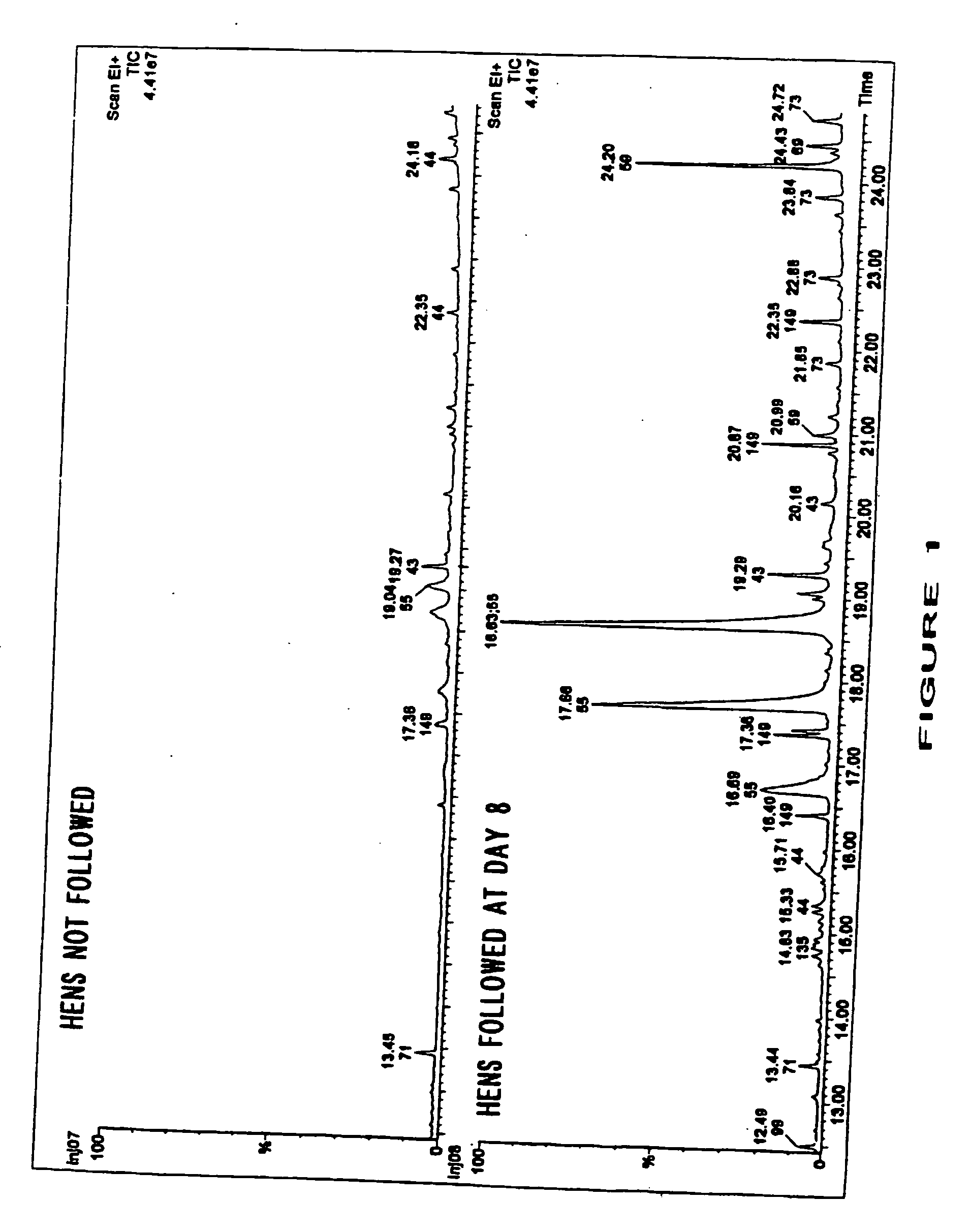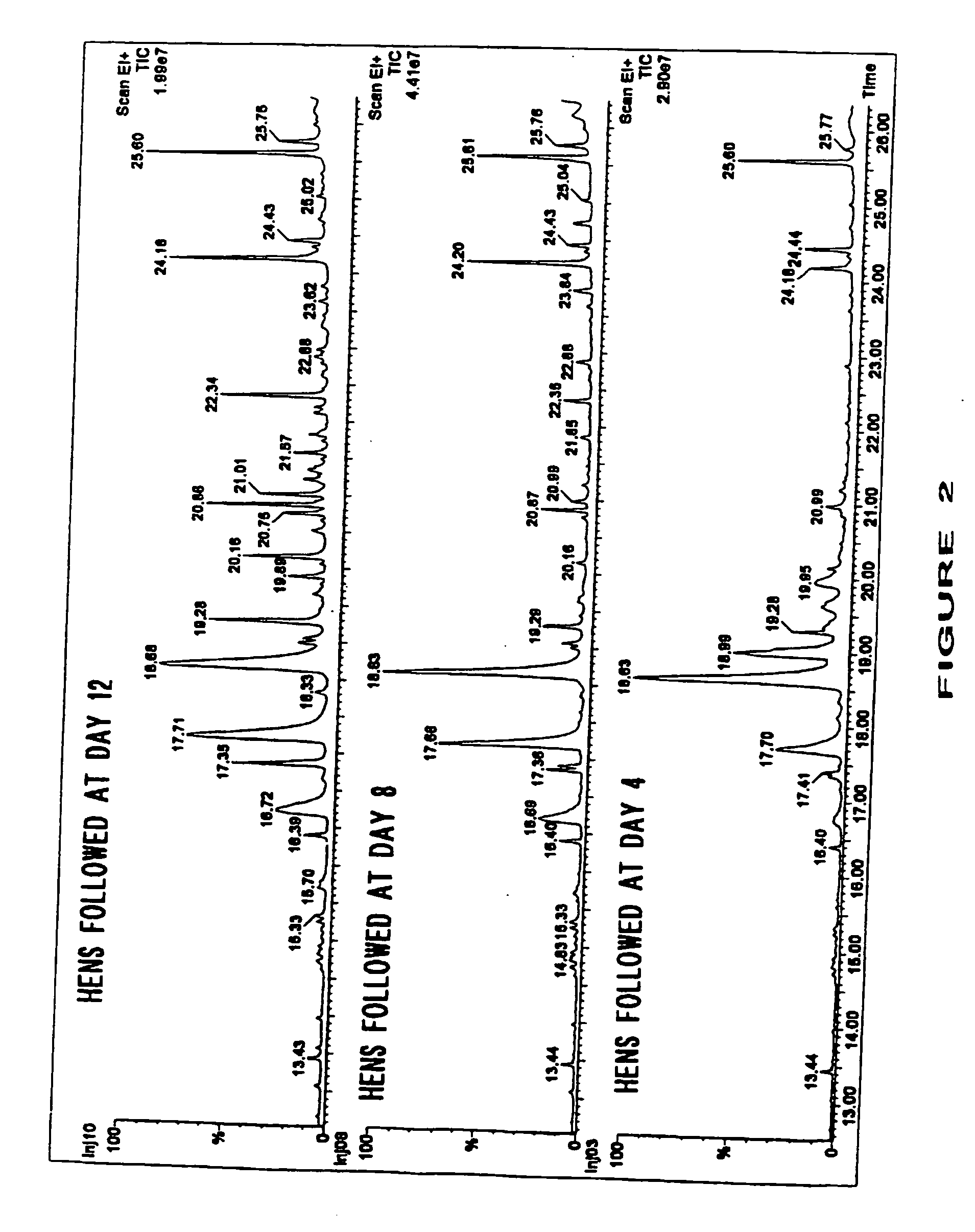Avian appeasing pheromones to decrease stress, anxiety and aggressiveness
a technology of reducing stress and anxiety, applied in the field of avian appeasing pheromones to decrease stress, anxiety and aggression, can solve the problems of mortality, loss of weight, and abnormally elevated corticosterone secretion, and achieve the effect of reducing anxiety and improving feed conversion
- Summary
- Abstract
- Description
- Claims
- Application Information
AI Technical Summary
Benefits of technology
Problems solved by technology
Method used
Image
Examples
example 1
[0084] Isolation and Analysis to Identify Pheromones from Hens
[0085] Female hens that were followed by their young or not followed by their young were used in this example. The samples were obtained in female chickens followed by their young in a period of day 4, day 8, day 12 and day 35 after hatching. Another set of samples was taken from hens that were not followed by their young.
[0086] The hens were rubbed around the area of the uropygial gland or tail gland with sterilized compresses several times. The compress was immediately placed in a flask containing 10 ml of dichloromethane.
[0087] The compress was then deabsorbed in dichloromethane by agitating the flask several times. Five ml of the sample was taken out and subjected to evaporation down to 1 ml. using air.
[0088] The samples were then subjected to grass chromatography / mass spectroscopy (GC / MS) using a Turbo Mass spectrometer made by Perkin Elmer. The detection was effectuated on impact using (EI+) at an energy of 70 e...
example 2
[0093] Effect of Avian Appeasing Pheromone on Weight in Young Chicks
[0094] The following example was performed under the following breeders conditions:
[0095] Type of breeding: semi-open housing
[0096] Feeding: ad libitum for food and water with the food commonly used by all breeders to feed young chicks.
[0097] Two separate lots of young chicks were divided. Lot A received a dosage of 2% of the Avian Appeasing Pheromone comprising 13% lauric acid (w % / w %), 40% palmitic acid (w % / w %), 34% linoleic acid (w % / w %) and 13% oleic acid (w % / w %) which was placed in an electronic diffuser and placed above the young chicks in their housing. Lot B received a treatment with a placebo.
[0098] Prior to administering the avian appeasing pheromone or the placebo the young chicks were also grouped according to their weight; i.e., at day 0.
[0099] The results are shown in FIGS. 3 and 4 where the groupings of the young chicks at day 0 were the same. From these Figures it was ascertained that wi...
example 3
[0101] The Effect of Avian Appeasing Pheromone in Chronic Stress Provoked in Hens and Roosters
[0102] This example measured the influence of avian appeasing pheromone in hens and roosters subjected to hard and chronic stress.
[0103] The stressful conditions in which the hens and chickens were subjected to include bright lights, metallic noises, and electric shock. Two types of stressors were provoked each day for a period of 15 minutes in a random manner, which were identical for the two lots.
[0104] Lot A was treated with the avian appeasing pheromone (MP) comprising 13% lauric acid (w % / w %), 40% palmitic acid (w % / w %), 34% linoleic acid (w % / w %) and 13% oleic acid (w % / w %). Lot B was given a placebo. Several factors were then tested such as whether the hens or roosters gained weight, the changes in cortisol levels and the changes in T4 levels using standard tests for cortisol and T4, 8 days after the end of the experiment.
[0105] A difference in weight was not significantly ob...
PUM
| Property | Measurement | Unit |
|---|---|---|
| temperature | aaaaa | aaaaa |
| length | aaaaa | aaaaa |
| electric | aaaaa | aaaaa |
Abstract
Description
Claims
Application Information
 Login to View More
Login to View More - R&D
- Intellectual Property
- Life Sciences
- Materials
- Tech Scout
- Unparalleled Data Quality
- Higher Quality Content
- 60% Fewer Hallucinations
Browse by: Latest US Patents, China's latest patents, Technical Efficacy Thesaurus, Application Domain, Technology Topic, Popular Technical Reports.
© 2025 PatSnap. All rights reserved.Legal|Privacy policy|Modern Slavery Act Transparency Statement|Sitemap|About US| Contact US: help@patsnap.com



